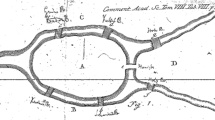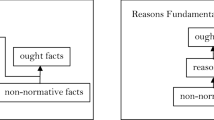Abstract
Naïve realism is a theory of perception with great explanatory ambitions. It has been influentially argued that, in order to realize these explanatory ambitions, the naïve realist should say that any perception belongs to just one fundamental kind. I think, however, that adopting this commitment does not particularly help the naïve realist to realize her explanatory ambitions, and so is not warranted. This result is significant because once this commitment about fundamental kinds is relinquished, we see that it is possible to develop some new and surprising forms of naïve realism—most notably, what I call pluralist naïve realism.
Similar content being viewed by others
Change history
30 July 2021
Springer Nature's version of this paper was updated to present the correct labeling from the claims in several arguments in Sections 6 and 7.
Notes
For naïve realists interested in explaining this datum, see fn. 1. Note that hallucinations also have presentational character.
For naïve realists interested in explaining this datum, see fn. 2.
For naïve realists interested in explaining this datum, see fn. 2.
For advocates of naïve realism, see fns. 1–3.
I explain why I prefer to avoid this narrower formulation in Mehta (2021), but the issue will not affect the arguments of this paper.
Naïve realists still must explain why hallucinations have presentational character, but there are many standard strategies for doing this. I mention a new strategy later in this paper.
Many would argue that naïve realism is not uniquely positioned to explain these data—see for example, (Metha 2014); Schellenberg (2018). A few would argue that naïve realism is not even particularly well-positioned to explain some of these data—see for example, Millar (2014). Here I bracket such concerns.
See the theorists cited in fn. 3.
See Crane (2006, p. 139); Nudds (2009, p. 337); Brewer (2011, p. 3).
In addition, other theorists—in particular, Soteriou (2005, p. 178); Gomes (2017, p. 534)—understand fundamental kinds as maximally specific phenomenal kinds. These theorists also do not explain why naïve realists should be monistic naïve realists, but I think that it is easy enough to fill in some good reasoning here, so I will set this view aside.
I say “targets” where most would say “objects,” since the latter term is also used to refer to.
See Mehta (2014); Mehta (under review). I take from Johnston (2004), and subsequently Conduct (2012), the idea that perceptions and hallucinations both involve awareness of universals, while only perceptions involve awareness of particulars. Where I disagree with Johnston is about his view that perception involves only a single kind of awareness of universals and particulars. For reasons that will be made clear very shortly, I think that these are two quite different kinds of awareness.
See Mehta (under review).
Of course, the original story was introduced in Jackson (1982).
Sensing naïve realism is similar to the view of Johnston (2004).
I continue the discussion in Mehta (under review).
This interpretation is suggested in Logue (2013, p. 109).
Regarding the first claim, Pautz (2007, p. 528) worries that particles of dust do not belong to at least one maximally specific kind. Regarding the second claim, Mehta (2014, p. 327) worries that a single perception might belong to several maximally specific but “cross-cutting” kinds. This worry relies on the idea that the conjunction of two kinds does not always yield a third kind.
Here the property of being female is to be understood as a sex property, not as a gender property.
Technically, it does not even entail the second problematic claim that every entity belongs to at least one maximally specific kind, full stop. For it allows that an entity might belong to an infinite series of ever-more specific maximally specific kinds. However, this does not help with Pautz’s worry, as described in fn. 26.
As Byrne and Logue put it: “Let the essences look after themselves—we can still perceive the world as ‘directly’ as we would wish” (2008, p. 82).
Similar, but not identical. For example, a perception might result in a genuinely singular belief, whereas a matching hallucination will instead result only in a putatively singular belief.
See Martin (2004, p. 64).
Again, this idea is anticipated by Johnston (2004) and developed carefully in Mehta (under review), but there are other possibilities as to what the commonality might be: perhaps, these subjects are both employing conscious representational capacities of the same type, or perhaps, they are both exercising the same conscious capacities to single out and discriminate particulars (see Schellenberg (2018)).
On this last point, I am in perfect agreement with Johnston (2004).
Or the appearance thereof, if that is different.
Martin may be right to think that screening-off worries apply in cases where we are comparing an explanation of something in terms of a determinate to an explanation in terms of a determinable. My point is that the present explanation does not have that structure.
See Mehta (under review).
See Logue (2013, pp. 108–109). All emphases are hers. Notice that in the first quotation, Logue moves smoothly from talk about kinds to talk about characterizations.
To be clear, I am not certain that Logue would endorse (EP2). All that is clear is that she endorses (EP1).
See Logue (2012a).
References
Allen, K. (2011). Revelation and the nature of colour. Dialectica, 65(2), 153–176.
Alston, W. (1999). Back to the theory of appearing. Philosophical Perspectives, 13, 181–203.
Bayne, T. (2009). Perception and the reach of phenomenal content. Philosophical Quarterly, 59(236), 385–404.
Beck, O. (2018). Rethinking naïve realism. Philosophical Studies (online) 1–27.
Brewer, B. (2011). Perception and Its Objects. Oxford University Press.
Broi, A. (2020). Revelation and phenomenal relations. Philosophical Quarterly, 70(278), 22–42.
Byrne, A., & Logue, H. (2008). Either/or. In Adrian Haddock & Fiona Macpherson (Eds.), Disjunctivism: Perception, Action, Knowledge (pp. 57–94). Oxford University Press.
Campbell, J. (2002). Reference and Consciousness. Oxford University Press.
Crane, T. (2006). Is there a perceptual relation? In T. Gendler & J. Hawthorne (Eds.), Perceptual Experience (pp. 126–146). Oxford University Press.
Fine, K. (1994). Essence and modality. Philosophical Perspectives, 8, 1–16.
Fish, W. (2009). Perception, Hallucination, and Illusion. Oxford University Press.
French, C. (2013). Perceptual experience and seeing that p. Synthese, 190, 1735–1751.
Genone, J. (2016). Recent work on naïve realism. American Philosophical Quarterly, 53(1), 1–24.
Gomes, A. (2017). Naïve realism in Kantian phrase. Mind, 126, 529–578.
Goodman, N. (1983). Fact, Fiction, and Forecast (4th ed.). Harvard University Press.
Hellie, B. (2007). Factive phenomenal characters. Philosophical Perspectives, 21, 259–306.
Jackson, F. (1982). Epiphenomenal qualia. Philosophical Quarterly, 32, 127–136.
Johnston, M. (1992). How to speak of the colors. Philosophical Studies, 68, 221–263.
Johnston, M. (2004). The obscure object of hallucination. Philosophical Studies, 120, 113–183.
Kennedy, M. (2009). Heirs of nothing: The implications of transparency. Philosophy and Phenomenological Research, 79(3), 574–604.
Kennedy, M. (2013). Explanation in good and bad experiential cases. In F. Macpherson & D. Platchias (Eds.), Hallucination: Philosophy and Psychology (pp. 221–254). MIT Press.
Lewis, D. (1983). New work for a theory of universals. Australasian Journal of Philosophy, 61(4), 343–377.
Logue, H. (2012a). Why naïve realism? Proceedings of the Aristotelian Society, 112(2), 211–237.
Logue, H. (2012b). What should the naïve realist say about total hallucinations? Philosophical Perspectives, 26, 173–199.
Logue, H. (2013). Good news for the disjunctivist about the bad cases. Philosophy and Phenomenological Research, 86(1), 105–133.
Martin, M. (2002). The transparency of experience. Mind and Language, 17(4), 376–425.
Martin, M. (2004). The limits of self-awareness. Philosophical Studies, 120, 37–89.
Martin, M. (2006). On being alienated. In T. Gendler & J. Hawthorne (Eds.), Perceptual Experience (pp. 354–410). Oxford University Press.
Masrour, F. (2011). Is perceptual phenomenology thin? Philosophy and Phenomenological Research, 83(2), 366–397.
McLaughlin, B. (2003). The place of color in nature. In R. Mausfeld & D. Heyer (Eds.), Colour Perception: Mind and the Physical World (pp. 475–502). Oxford University Press.
Mehta, N. (2014). The limited role of particulars in phenomenal experience. Journal of Philosophy, 111(6), 311–331.
Mehta, N. (2021). The fragmentation of phenomenal character. Philosophy and Phenomenological Research, 00, 1–23.
Millar, B. (2014). The phenomenological directness of perceptual experience. Philosophical Studies, 170, 235–253.
Neta, R. (2008). In defence of disjunctivism. In A. Haddock & F. Macpherson (Eds.), Disjunctivism: Perception, Action, Knowledge (pp. 311–329). Oxford University Press.
Nudds, M. (2009). Recent work in perception: Naïve realism and its opponents. Analysis Reviews, 69(2), 334–346.
Pautz, A. (2007). Intentionalism and perceptual presence. Philosophical Perspectives, 21(1), 495–541.
Schellenberg, S. (2018). The unity of perception: Content, consciousness, evidence. Oxford University Press.
Sider, T. (2011). Writing the Book of the World. Oxford University Press.
Siegel, S. (2006). Which properties are represented in perception? In T. Gendler & J. Hawthorne (Eds.), Perceptual Experience (pp. 481–503). Oxford University Press.
Soteriou, M. (2005). The subjective view of experience and its objective commitments. Proceedings of the Aristotelian Society, 105, 177–90.
Wiggins, D. (1980). Sameness and Substance. Blackwell.
Wiggins, D. (2001). Sameness and substance renewed. Cambridge University Press.
Acknowledgements
In the course of writing this article, I have benefitted from the wonderfully detailed written comments of Ori Beck, Brian Cutter, and Boyd Millar. I have also learned from my conversations with Ben Blumson and Matt Walker and from an audience at the 2018 Australasian Association of Philosophy conference. This work was supported by grant IG16-SR003, funded by Yale-NUS College and the Singapore Ministry of Education.
Author information
Authors and Affiliations
Corresponding author
Ethics declarations
Competing Interests
The authors declare no competing interests.
Additional information
Publisher's note
Springer Nature remains neutral with regard to jurisdictional claims in published maps and institutional affiliations.
Rights and permissions
About this article
Cite this article
Mehta, N. Naïve Realism with Many Fundamental Kinds. Acta Anal 37, 197–218 (2022). https://doi.org/10.1007/s12136-021-00477-x
Received:
Accepted:
Published:
Issue Date:
DOI: https://doi.org/10.1007/s12136-021-00477-x




